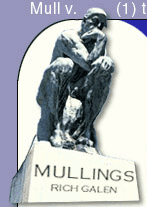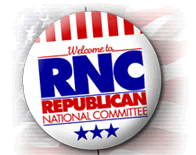
|
So, the decision was made to go to Arlington National Cemetery on Monday to attend the annual Memorial Day observance. The Lad was in charge of President Bush's appearance and he graciously offered to get us seats in the Amphitheater to watch. The entrance to Arlington National Cemetery, for those who have never been, is directly across the Potomac River from the Lincoln Memorial. The Memorial Bridge connects these two historical - almost mystical - sites. At the entrance there is a sign which asks visitors to remember this is an active cemetery with the words: "Welcome to Arlington National Cemetery, America's most sacred shrine. These are hallowed grounds." Assume, for the purposes of this essay, that the phrase, "And then my eyes teared up" has been written every other paragraph, or so. The Mullings Director of Standards & Practices and I made our way up the walkways, past the small groups of school-aged children and their chaperones listening to a docent explain what they were looking at. One of the things they were looking at were rows and rows of American flags which had been placed in the ground front of each and every headstone. There are over a quarter of a million people buried at Arlington. Each headstone got its own flag. Generals and privates, Admirals and seamen. Each got a flag. Each the same size. We wandered around the grounds, map in hand, grass wet from days of thunder storms, the morning still cloudy and threatening. We stopped, having found what we were looking for, then made our way to the Amphitheater where the ceremony would take place. As we approached, I picked The Lad out of the crowd. He saw us almost simultaneously. This is, I suspect, exactly the same gene-driven mechanism which allows a wildebeest to pick out her calf from among all the other wildebeests in the herd. The Lad led us through a roped-off area, through a set of magnetometers and to our seats to the rear and to one side of the semicircle. As the crowd quietly filtered in, elderly vets handed out small American flags. As the Air Force Band and Chorus began to perform the sun peeked out. The musicians played a medley of patriotic tunes: "This is My Country", "America the Beautiful", "God Bless America" (during which the crowd had begun waving its flags in time to the music), and ending with "The Battle Hymn of the Republic." An announcer informed us that we would shortly hear a 21-gun salute which would signal the arrival of the President on the grounds. Sure enough, a few minutes later, off in the distance, we could hear a order followed by the report of a cannon, then another order, another report, and so on twenty-one times. During it all, the crowd stood silently. The announcer then said the President would lay a wreath at the Tomb of the Unknowns preceded by the Army band playing the National Anthem. The Tomb of the Unknowns is located to the rear of the Amphitheater on a large, elevated deck, out of our sight. At the playing of the National Anthem, the military personnel snapped a salute and everyone else put hands on hearts. After a delay, very faintly, we could hear the sound of taps. The crowd was hardly breathing; as if breathing would drown out the sound of the bugle. Mrs. Bush took her seat, without fanfare, in a raised area to the left of the stage. Applause rippled through the crowd as people recognized her. The President arrived on the stage without Ruffles and Flourishes. A large round of applause greeted him as he waved, then quickly took his seat. After the opening prayer, there was a recitation of letters. One written by a young man who, sometime after writing home, had been killed in Viet Nam; the famous appeal for aid by Col. William Barret Travis at the Alamo ("I am determined to sustain myself as long as possible & die like a soldier who never forgets what is due to his own honor & that of his country."); and, a letter written by Abraham Lincoln to a woman who lost five sons in the Civil War. When the recitation was completed, there was no applause. The crowd was silent. The President spoke, quietly, of sacrifice and of duty, and of honor. He spoke of young men and young women who would never live out their lives. He spoke of the last kiss from a husband to his wife; or the last wink and wisecrack of a brother to a sister as a train pulled out of a station, bound for war. This was not a ceremony of pomp and circumstance. This was not an occasion for soaring rhetoric. After the ceremony was over we walked around to the Tomb of the Unknowns and watched the Changing of the Guard. Here, too, the crowd, watched silently, this military ballet which takes place 24 hours a day, seven days a week. On the other side of our continent, in Hollywood on this Memorial Day, producers are breathlessly measuring the box office of a $140 million dollar movie about Pearl Harbor; a movie with the color, the action, and the sounds of war - at least the way we have come to know Hollywood's version of it. Arlington National Cemetery, on Memorial Day, is the place where, and the day when, we remember the men and women who were killed at Pearl Harbor, and on Omaha Beach, and at Bull Run, and Verdun, and in Korea, and Viet Nam, and all the other places where we have sent young men and women to fight and die. Above the stage in the Amphitheater there is an inscription which reads: "We, here, highly resolve that those dead shall not have died in vain." Arlington National Cemetery, on Memorial Day, has nothing to do with multi-million dollar epics, and computer generated images. It has nothing to do with the sweep and grandeur of history, nor the gigantic commitment of resources to battles and wars; nor of grand strategies and brilliant tactics. It has to do with one white headstone. Nestled, in a neat row, among the hundreds of thousands of white headstones next to it, in front of it, and behind it. Up hills and down swales. One white headstone, among a quarter of a million others. We had found the one with the words: John Hugh Curran
Map in hand, in the wet grass, on a cloudy morning, of Memorial Day, at Arlington National Cemetery, we paid our respects to her dad. And prayed, silently, that he rest. In peace.
Copyright © 2001 Richard A. Galen 
|









